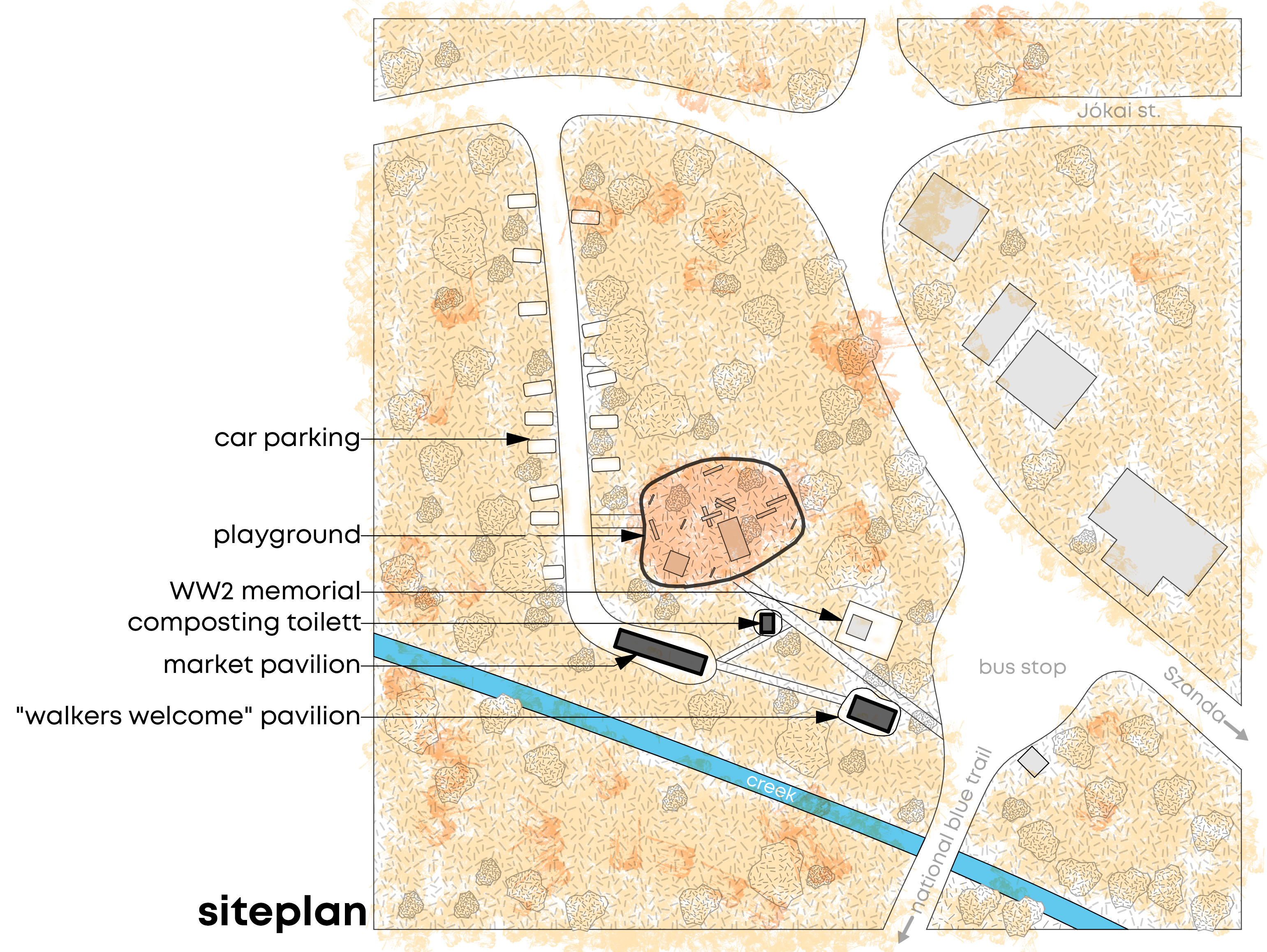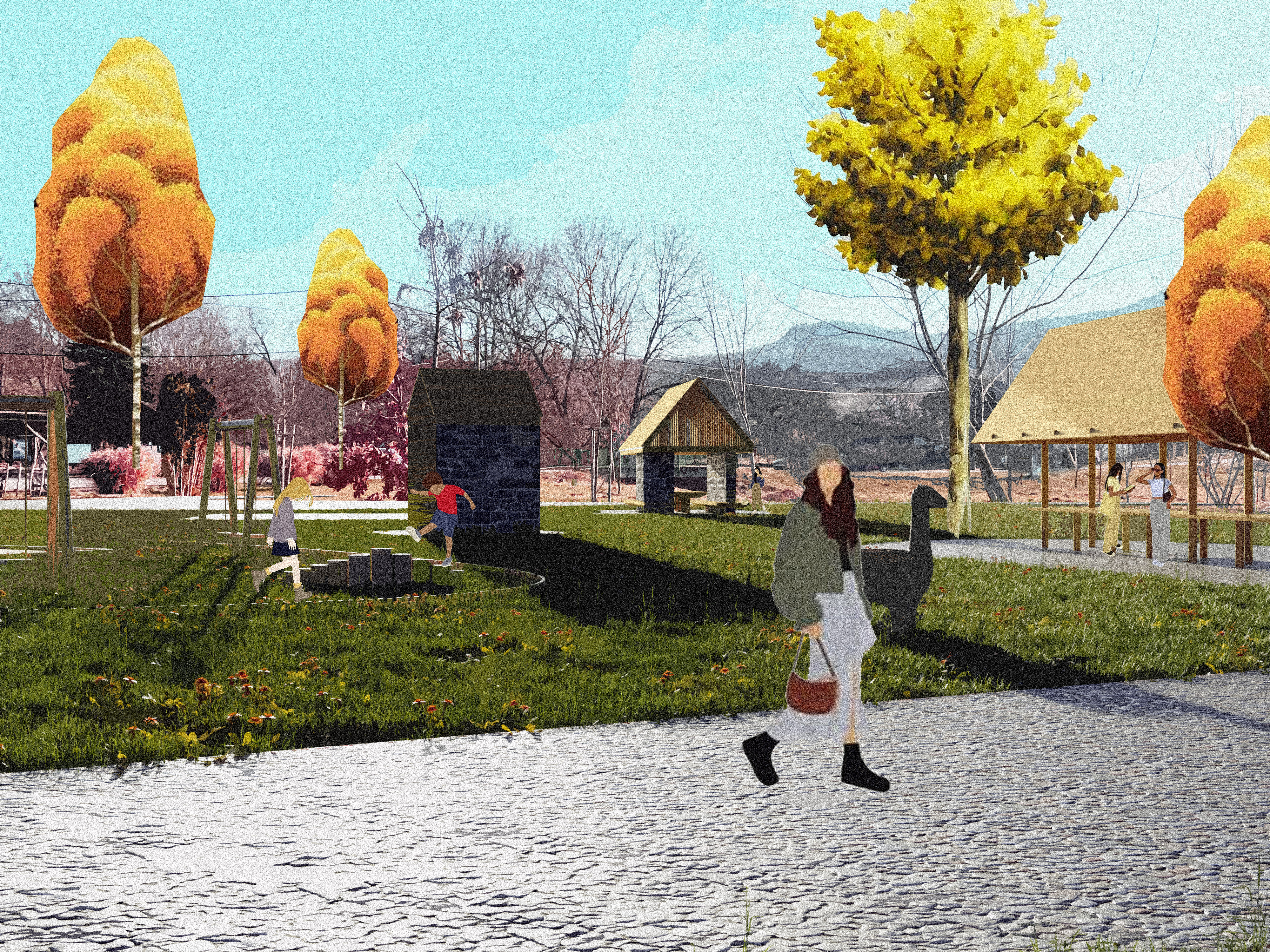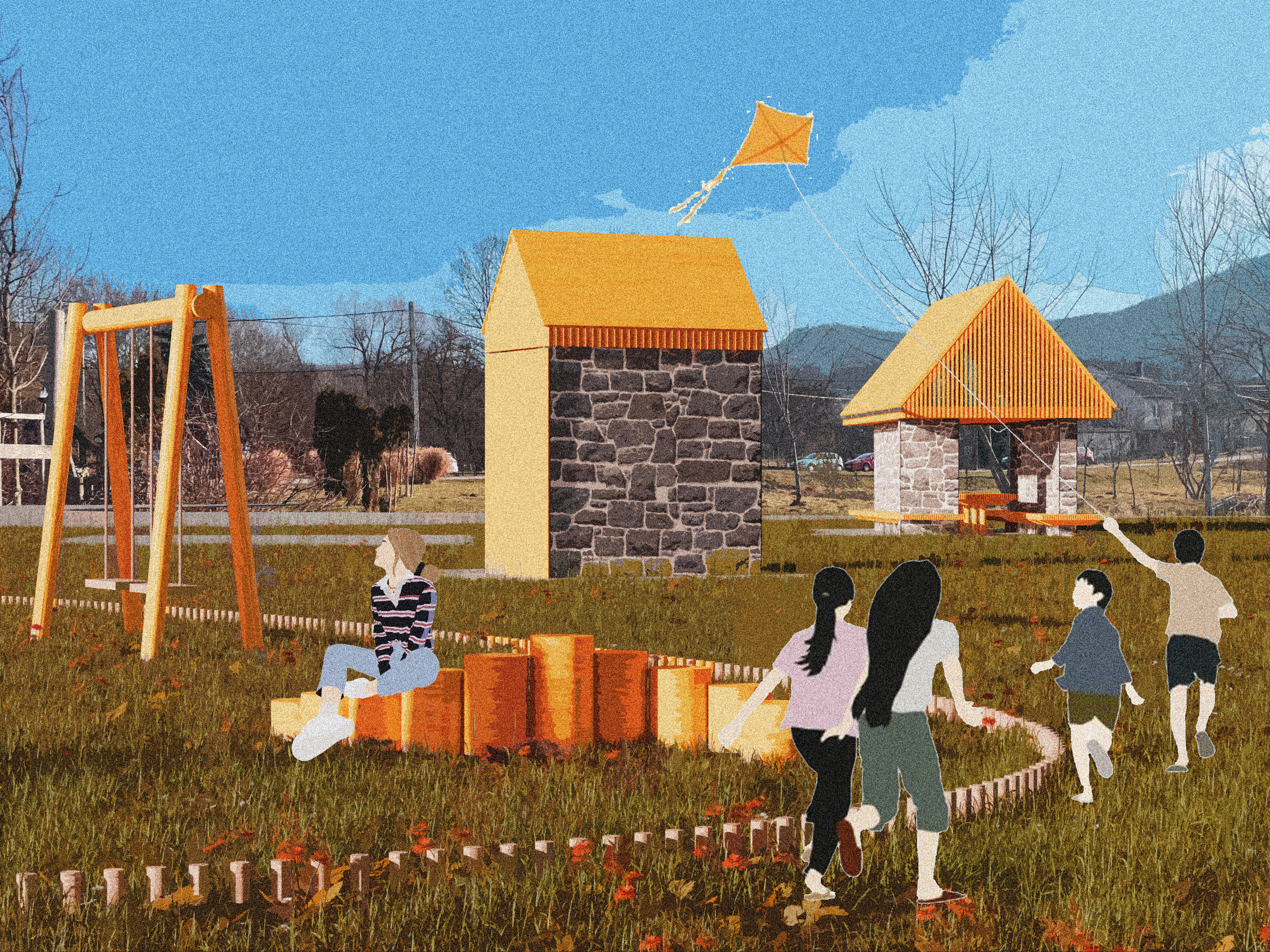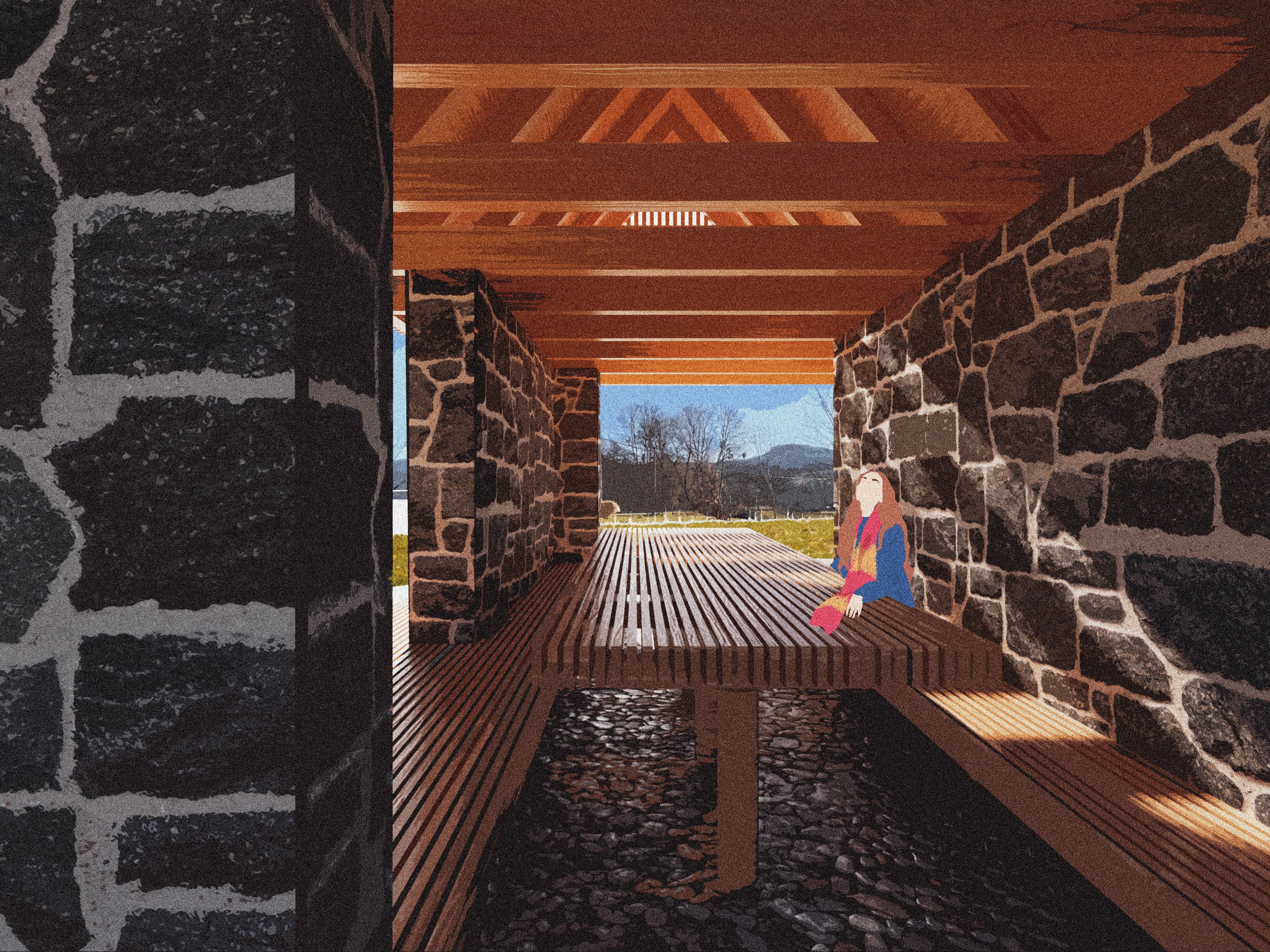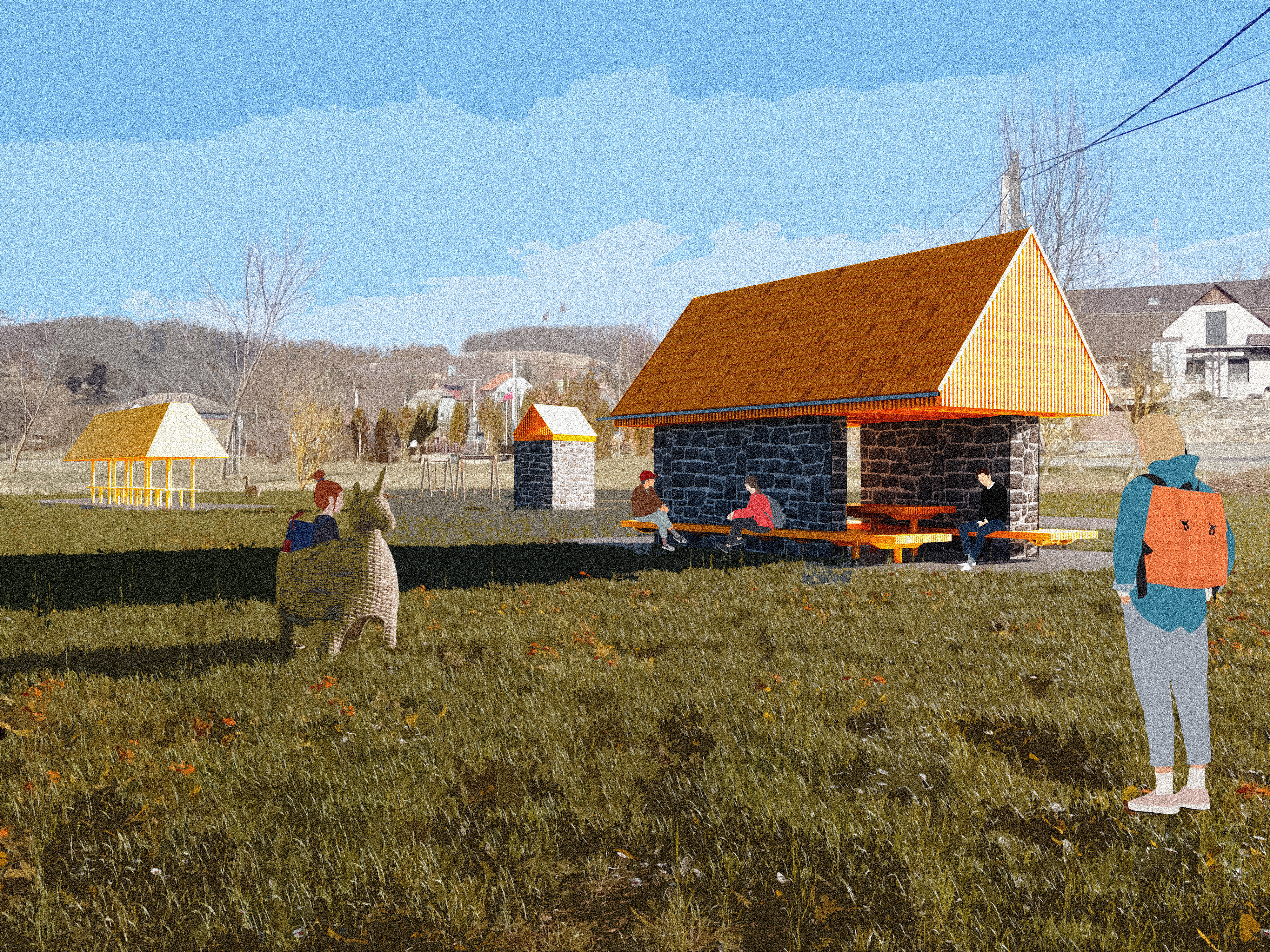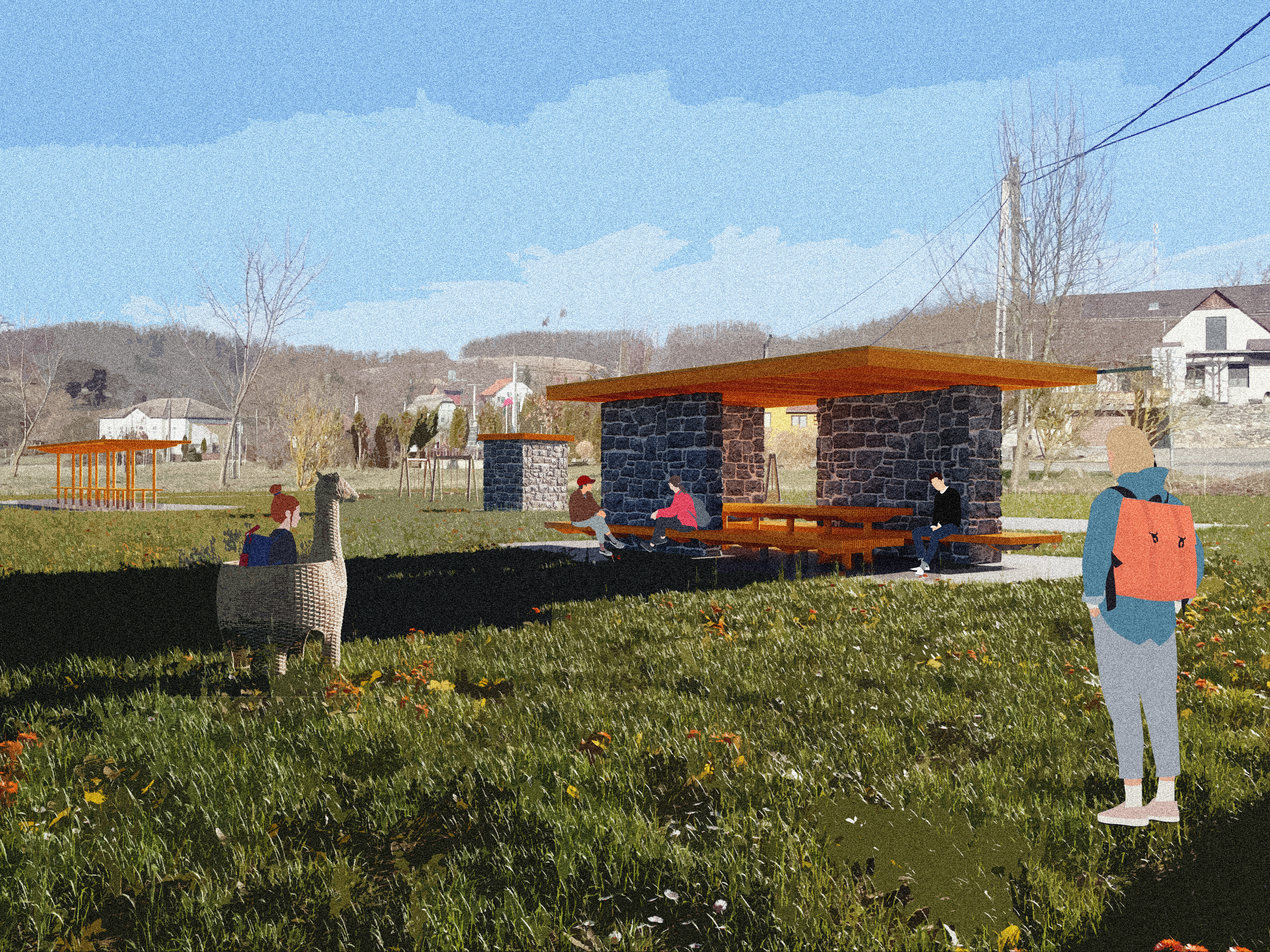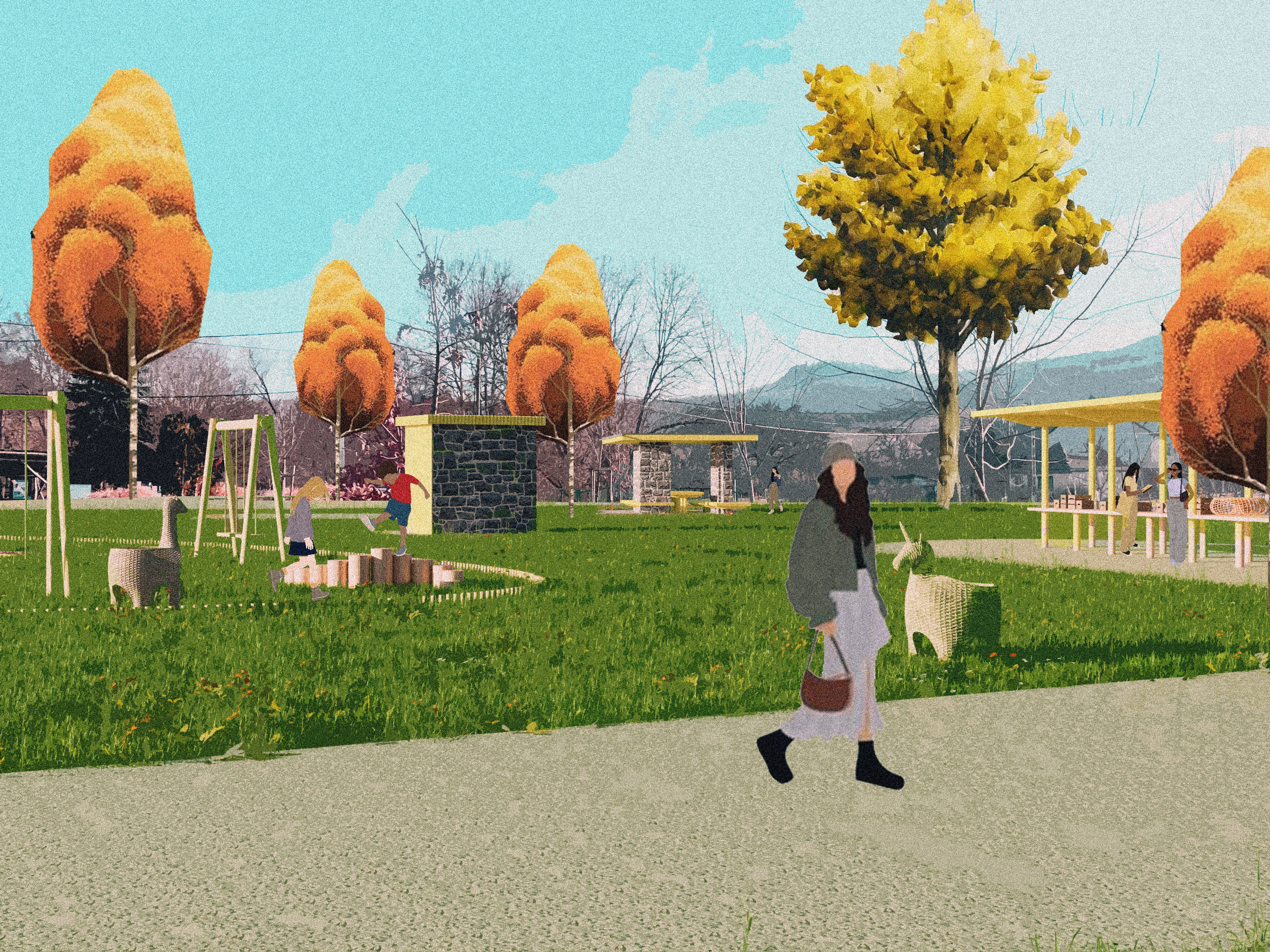Walkers Welcome
Recreational space for pedestrian tourists
The 'Walkers Welcome' initiative aims to make up for a hiatus in the infrastructure of Szanda-Szandaváralja by providing a cosy space for tourists and locals. It is the first step of a larger regeneration project on the bank of Szandaváralja Stream.
Hungary
Szanda, land registry number 556
Early initiative
Yes
Yes
Yes
No
No
13754: Szanda (HU)
The ‘Walkers Welcome’ rest stop in Szandaváralja is a long-awaited and much-needed addition to the infrastructure of the village, introducing community design, referencing local heritage through innovative solutions, carried out via community effort and with sustainable, locally sourced materials. While its design and implementation connect generations and local stakeholders, its end result, the wooden structure of the rest stop is an investment in one of the main areas of income for the village: sustainable tourism. Located in the picturesque Cserhát hills, Szandaváralja is a very popular destination for hikers of the National Blue Trail, an iconic tourist route in Hungary. However, Szanda and Szandaváralja have thus far merited very little from the stimulating effects of tourism, while enduring its negative impact, i.e. wastage. Complete with a composting toilet, the rest stop addresses the problem of waste as well as offers a welcoming spot for tourists and walkers to linger, paving the way for an extended community space for locals, and further infrastructure harnessing pedestrian traffic passing through the village. The ‘Walkers Welcome’ rest stop is part of a larger plan to furbish the area and create a more spacious recreational space as well as a market area. The latter would directly benefit local producers as well as invigorate sustainable tourism. Structures added later to the rest stop and its surroundings will express the same principles of sustainable architecture, a strong sense of heritage and innovative design. Building materials will be locally and ethically sourced, and the design of the rest stop will be co-created by a local artist and children attending 2 educational institutions: the local state-owned kindergarten and a non-governmental primary school. The ‘Walkers Welcome’ rest stop will boost local businesses and sustainable tourism while clearly expressing the guiding principles of sustainability.
Local answers to global challenges
Sustainable tourism as part of the National Blue Trail
Sustainable use of materials
Green pedagogy
Co-creation with public involvement
Sustainability as a guiding principle leads the design and implementation of the ‘Walkers Welcome’ rest stop. Primarily, the materials and ethos of construction are deeply sustainable: the use of locally available materials such as wood from the local woods and stone from the nearby quarry; the composting toilet shows the best possible solution to the sewage issue of the village, the rest stop will alleviate the waste problem along the National Blue Trail. Secondly, the inherent message of green pedagogy: involving local children and emphasizing sustainability in the use of materials as well as the structure’s purpose ensures the transmission of these values to future generations. The social impact of even such a small-scale project, enhanced by the workshops, co-creation process and public events will work to build bridges across the community, reward citizens with a sense of accomplishment, and increase civic resilience – a key means to counter possible future environmental challenges. The landscaping of the area will include the revitalization of the banks of the seasonal creek that borders the site from one side and the planting of endemic species.
The scale and proportions of small-scale vernacular architecture, through the use of timber structure and the detailing of sheds, henhouses and barns will be transferred and implemented into the architectural. Local basalt stone will be used as a tribute to the ruins of Szanda Castle.
. This project is groundbreaking as the first community space structure co-created by locals, with a unique emphasis on active involvement from children. Their creativity will leave a lasting imprint, blending traditional ‘Palóc’ architectural elements with innovation for future generations.
Through collaborative workshops, children from the local kindergarten (ages 2.5–7) and the non-governmental green school (ages 6–14) will engage with woodworking while also working with stories and folk tales passed down by older generations. These narratives, centered around Szanda Castle and regional folklore, will inspire elements of the design, allowing children to translate history into physical form. This hands-on experience not only strengthens their appreciation for local traditions but also instills a sense of pride and ownership in the built environment.By integrating both tradition and innovation, the rest stop serves as a model for participatory design. It enhances the hiking experience along the Blue Trail, functioning as both a resting place and a cultural landmark. The inclusion of a composting toilet further addresses local infrastructure needs, introducing a sustainable and mindset shifting solution where sanitary sewers are lacking.
Through thoughtful design and meaningful intergenerational collaboration, the initiative demonstrates how architecture can foster cultural continuity, inspire creativity, and create a welcoming, high-quality public space that resonates emotionally with both locals and visitors.
. This project is groundbreaking as the first community space structure co-created by locals, with a unique emphasis on active involvement from children. Their creativity will leave a lasting imprint, blending traditional ‘Palóc’ architectural elements with innovation for future generations.
Through collaborative workshops, children from the local kindergarten (ages 2.5–7) and the non-governmental green school (ages 6–14) will engage with woodworking while also working with stories and folk tales passed down by older generations. These narratives, centered around Szanda Castle and regional folklore, will inspire elements of the design, allowing children to translate history into physical form. This hands-on experience not only strengthens their appreciation for local traditions but also instills a sense of pride and ownership in the built environment.By integrating both tradition and innovation, the rest stop serves as a model for participatory design. It enhances the hiking experience along the Blue Trail, functioning as both a resting place and a cultural landmark. The inclusion of a composting toilet further addresses local infrastructure needs, introducing a sustainable and mindset shifting solution where sanitary sewers are lacking.
Through thoughtful design and meaningful intergenerational collaboration, the initiative demonstrates how architecture can foster cultural continuity, inspire creativity, and create a welcoming, high-quality public space that resonates emotionally with both locals and visitors.
The ‘Walkers Welcome’ rest stop is designed due to a tangible popular will expressed clearly in the 2024 municipal elections the current board has been nominated through. The planning and design of the rest stop take place in close cooperation across the municipal board, the mayor, two acitve local citizens, as well as the children attending the local kindergarten and the ‘BPS Green School’ who also take active part in the process. When completed, it will bear witness to the resilience, potential and innovative skills of a village, against the backdrop of an underprivileged regional status, lack of resources and bargaining power on a national level. The cooperation of stakeholders across sectors: 2 local NGOs are involved, working closely together with the municipality, integrating two distinct communities in the village: recent and generational residents, distinct mindsets and skillsets that so far have had a lack of platform to cooperate. This cooperation opens a new chapter in the life of Szanda-Szandaváralja, and is exemplary also on a national level, where a relocalization from cities towards rural areas have created populations of ‘newcomers’ from the city and original residents with generational roots in the given village or town. There is a lack of trust between stakeholders and this project already serves as an instrument for healing. The project will not only be created with the active involvement and initiative of locals but will also provide a space of recognition for hikers taking the ‘blue trail’ and other visitors. This little facility, designed and to be built with the involvement of older generation of locals and young age kids will be a platform for closing intergenerational gap and caring. We want to create and accessible resting stop, a simple yet thoughtful structure that represents these values and can be a best practice for other similar scale rural sites in Hungary.
The site chosen for the ‘Walkers Welcome’ rest stop strongly illustrates the civic resilience of Szandaváralja: the spot has been maintained mainly through voluntary work and partly through assistance by the municipality, and has hosted a number of community events, again carried out through voluntary work and the sheer enthusiasm of locals. Adding the pedagogical impact and community building effects of the rest stop’s co-creation, it would directly involve the Green School, a new generation of residents, inspire families to stay or move to the village, and also encourage sustainable tourism. The need for a hikers’ rest stop was clearly expressed by the population through the course of last year’s municipal elections. It is expected to solve the problem of littering as well as induce further investment in the area: boost one of the main sources of income for the village: tourism and imply further tangible benefit for locals: the establishment of a local producers’ market. As Szandaváralja is the ’smaller’ partner to Szanda in their joint municipal governance, investment in the area would also boost morale and balance the relationship of the villages, encouraging further civic involvement, which has always been present but remained fragmented. Acting as a bridge across the two villages: Szanda and Szandaváralja, across two communities: locals with generational roots and more recent residents with an urban background; setting off cooperation between the local kindergarten and the Green School, professing principles of 21ct century pedagogy and sustainable development, the rest stop is truly exemplary in the region as well as the country, plagued by low civic engagement and beleaguered public. Mobilizing local businesses and involving the public at several steps ‘Walkers Welcome’ would make the best of locally available human and material resources, while providing the village with a sense of pride, achievement and future perspective.
The ‘Walkers Welcome’ initiative was born at the intersection of a small municipality in a disadvantaged reason, yet endowed with natural and cultural resources, a strong sense of identity; and the urban skillsets channeled through recently settled residents. This becomes apparent from the list of stakeholders: the municipality, newly open to such initiatives; the only functioning institution i.e. the Kindergarten, the Budapest Green School, member of a non-governmental network based in the capital; as well as the civic society of citizens of Szandaváralja, dedicated to preserving and developing their home. The initiative is grassroots through and through, making the best possible use of locally available material and human resources, combining skillsets for the benefit of the whole community, while being embedded in the European mindset of sustainability and cooperation across sectors.
The principles of community architecture are ensured by the civic engagement with the professional support of the architect himself who entered the project with the intent of integrating input from the public and stakeholders as much as possible, through regular communication and dedicated planning events.
The planning and installment of the ‘Walkers Welcome’ rest stop will be a process of inclusive co-creation, consulting the public and stakeholders at regular intervals, as set out in the timeline; relying on and nurturing the civic engagement already present in the village.
Sustainable use of locally sourced materials, their sourcing and installment is granted by the municipality and the mayor, who is involved in forestry and wood trade in the surrounding area. The first plans of the rest stop here submitted are based on sustainably sourced local materials: wood and granite. ‘Walkers Welcome’ will provide the community with a hitherto unforeseen degree of civic participation in design and installment of a public structure.
Workshops with local children will follow the principles of Green pedagogy, as practiced by the Budapest Green School and built into the project timeline, with field trips and project-based learning serving as the foundation of children’s activities. Budapest Green School has brought a novel pedagogical approach with its project-based, modular teaching method and environmental themes, sustainability and permaculture receiving strong focus in the curriculum. The Kindergarten has won the ‘Green Kindergarten’ title twice in a row, boasting a garden tended by the children and several environment-conscious activities. The joint workshops will prove a great opportunity to expand and deepen the green pedagogical practices of both institutions.
The landscaping and planting will be designed in collaboration of an ecologist and a landscape architect.
The planning and installment of the ‘Walkers Welcome’ rest stop will be a process of inclusive co-creation, consulting the public and stakeholders at regular intervals, as set out in the timeline; relying on and nurturing the civic engagement already present in the village.
Sustainable use of locally sourced materials, their sourcing and installment is granted by the municipality and the mayor, who is involved in forestry and wood trade in the surrounding area. The first plans of the rest stop here submitted are based on sustainably sourced local materials: wood and granite. ‘Walkers Welcome’ will provide the community with a hitherto unforeseen degree of civic participation in design and installment of a public structure.
Workshops with local children will follow the principles of Green pedagogy, as practiced by the Budapest Green School and built into the project timeline, with field trips and project-based learning serving as the foundation of children’s activities. Budapest Green School has brought a novel pedagogical approach with its project-based, modular teaching method and environmental themes, sustainability and permaculture receiving strong focus in the curriculum. The Kindergarten has won the ‘Green Kindergarten’ title twice in a row, boasting a garden tended by the children and several environment-conscious activities. The joint workshops will prove a great opportunity to expand and deepen the green pedagogical practices of both institutions.
The landscaping and planting will be designed in collaboration of an ecologist and a landscape architect.
The main innovative aspect of the ‘Walkers Welcome’ rest stop is the direct involvement of stakeholders and the public in both design and installment of the structure. The co-creative process desired by all parties is starkly distinct from general practice in the region and on a national level, where development projects are characteristically designed and implemented with a top-down approach. The immediate region of Szanda-Szandaváralja as well as Nógrád county can be described as an underprivileged region lacking in resources and opportunities, the home of dwindling and aging populations. Over several decades, locals have been accustomed to little development and a deterioration of available infrastructure, and little choice over decisions impacting their homes. The ‘Walkers Welcome’ initiative can prove that the contrary is possible: an inclusive process stemming from, carried out in cooperation with, proving the resilience of, and inspiring further action by the public. Practical aspects in which the project is innovative is the use of locally sourced materials, again a novelty as opposed to top-down implemented commissions, as well as the immediate educational impact as a result of the co-creating workshops with local children. The project also serves an exemplary bridge-building function socially, uniting the skillsets of recent residents and answering the needs of locals with generational roots.
The methodology of ‘Walkers Welcome’ is based on the process of co-creation: consultation with the architect, involving the public and doing workshops with the children will run parallel and continue to the project’s completion. Timed to seep through the social fabric of Szanda- Szandaváralja with maximum effect, the 6-8 months of the project timeline will allow for thorough consultation, active involvement and a celebratory event at the project’s conclusion. ‘Walkers Welcome’ is the first step of an extended regenerative project on the bank of the Szandaváralja Stream, meant to spearhead long-term positive change. As such, the rest stop structure will attest the resilience and innovative skill of the community, offer a rewarding experience for residents, and potentially attract new citizens. It has the potential to halt one of the most harmful forms of social erosion: the migration of local workforce to larger towns and cities.
The inclusion of children, involving different age groups and 2 separate institutions from two distinct sectors: one state-owned the other private, is easily transferable practice in case of small municipalities. Linking these workshops to local sights, history and having a tangible end-result has the potential to address the whole community. Running parallel co-creation workshops, consultation with the municipality and dissemination events for the wider public is another key element of the methodology that is advised for application anywhere where similar projects are implemented. ‘Walkers Welcome’ turns a trait, often perceived by locals as a challenge: namely the small size of the villages and their lack of resources, into an advantage. Stemming primarily from scale, this approach can also be adopted by any smaller settlement within the European Union. The use of local materials, embeddedness in local culture, and broad public involvement will serve as a point of pride, connecting residents from several age groups and social backgrounds. Referencing local identity while striving for sustainability at every step in a clearly visible way, i.e. locally sources materials, composting toilet, developing infrastructure for pedestrian tourism, the ‘Walkers Welcome’ initiative connects the past and future of Szanda and Szandaváralja, another transferable practice. As stated in the Stakeholder document, the project aims to call in a wide range of actors, local businesses, producers and non-governmental organizations in the dissemination and extension of the project, a method clear from the outset, and potentially beneficial for any municipality.
The ‘Walkers Welcome’ initiative launches a process of bridge-building within the community as well as building cooperation in its vicinity. Strengthening the social fabric of Szanda-Szandaváralja both within and without will prove the most effective antidote in face of challenges such as: climate crisis, polarized public life, faltering institutions. These trends are already tangible and bound to hit a small settlement in an underprivileged region even harder. However, Szanda-Szandaváralja is still endowed with relatively rich natural and cultural resources, which the ‘Walkers Welcome’ initiative aims to fortify. Guided by the principle of sustainability, stemming for local needs and involving residents to the highest applicable degree, the project counteracts exploitative, destructive practices. Elevating the natural environment of the village as a point of pride, investing in sustainable (hiking) tourism, it encourages locals to cherish and protect the surrounding natural treasures. Directly involving children in the co-creation of the rest stop makes sure a new generation of residents has a deep understanding of sustainability as applied locally, and who have immediate experience of how to plan and design a structure in harmony with its environment. Referencing local identity while geared for the future, the project and methodology intend to encourage residents to engage in an inclusive and innovative way, and on many levels with their environment.
The ‘Walkers Welcome’ Rest Stop will be the first step in a wider regeneration effort around the Szandaváralja Stream, with main milestones planned as follows:
2025 - Building ‘Walkers Welcome’ Rest Stop
2027 - 2028 Market area & parking space
2028 - Park and Playground
2029 - Ecologically restored area with triple function: recreational space, tourist attraction, boost for local businesses.
The working method established by the project’s initial phase will be maintained throughout, and will be manifested emphatically at the beginning and end of the project. The involvement of secondary stakeholders will hopefully come to full fruition by 2028 where stakeholders will be actively involved in the ecological restoration of the stream banks. The method of co-creation started on a smaller scale will grow to employ the combined skillset and expertise of primary and secondary stakeholders who all benefit from the project: through business, ecological principles carried out in practice, and an improved quality of life for locals. The municipality is committed to carrying through the project in its entirety, and will look for sources of funding, grants and sponsors continually.
2025 - Building ‘Walkers Welcome’ Rest Stop
2027 - 2028 Market area & parking space
2028 - Park and Playground
2029 - Ecologically restored area with triple function: recreational space, tourist attraction, boost for local businesses.
The working method established by the project’s initial phase will be maintained throughout, and will be manifested emphatically at the beginning and end of the project. The involvement of secondary stakeholders will hopefully come to full fruition by 2028 where stakeholders will be actively involved in the ecological restoration of the stream banks. The method of co-creation started on a smaller scale will grow to employ the combined skillset and expertise of primary and secondary stakeholders who all benefit from the project: through business, ecological principles carried out in practice, and an improved quality of life for locals. The municipality is committed to carrying through the project in its entirety, and will look for sources of funding, grants and sponsors continually.

